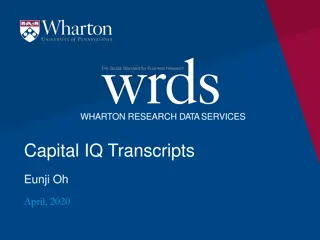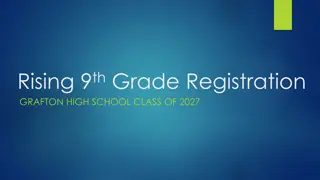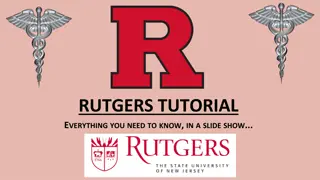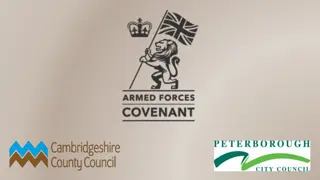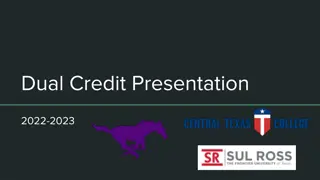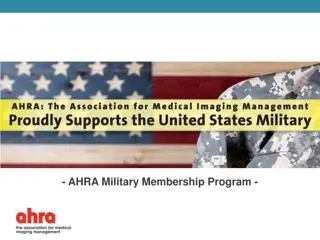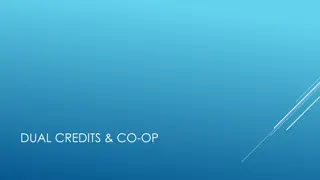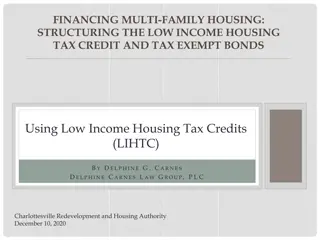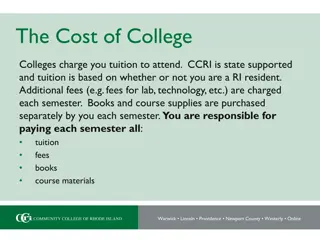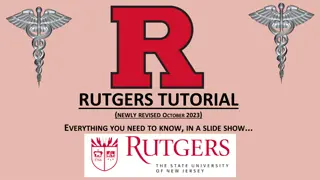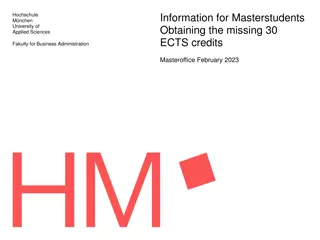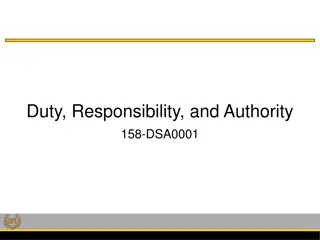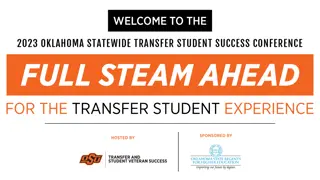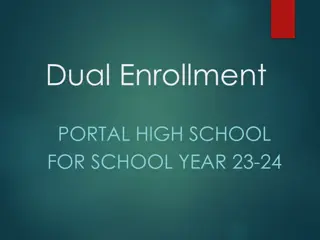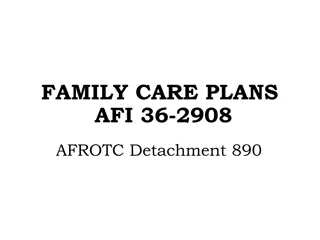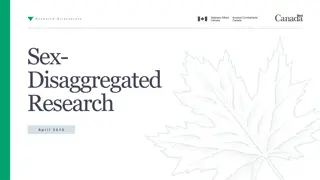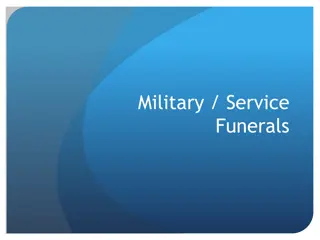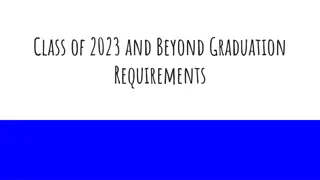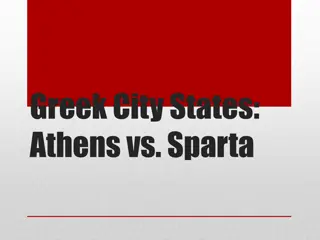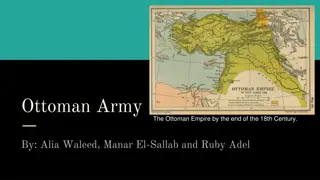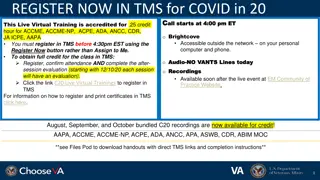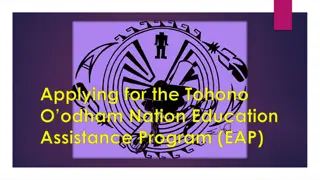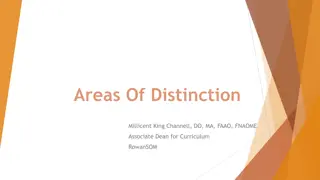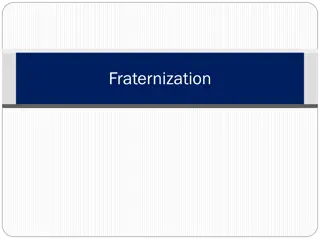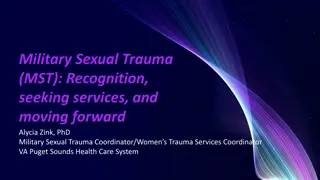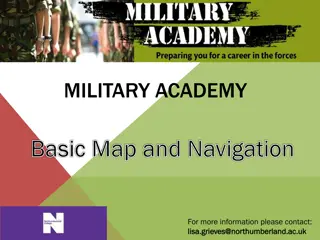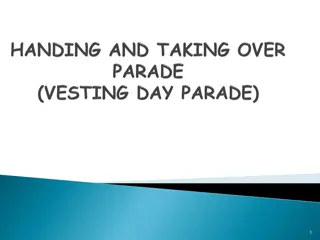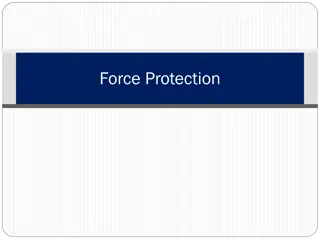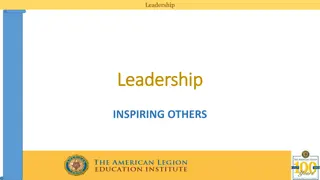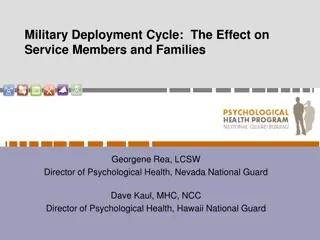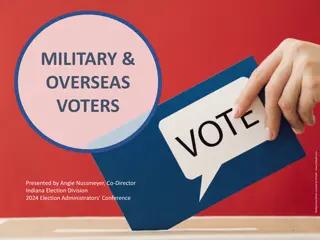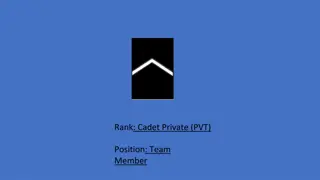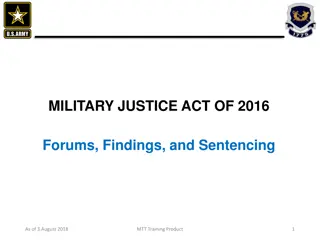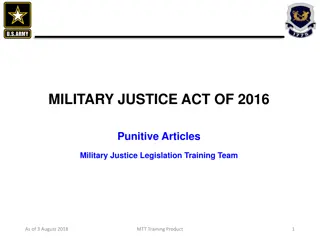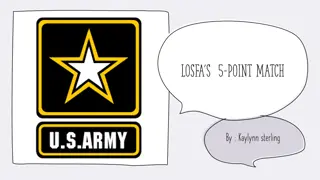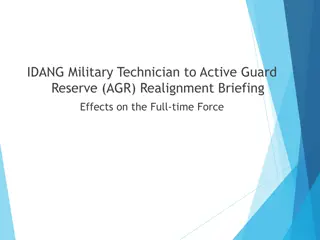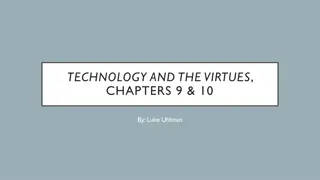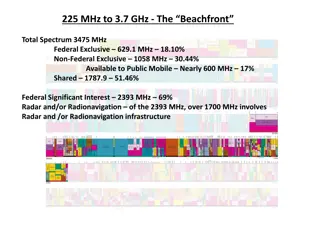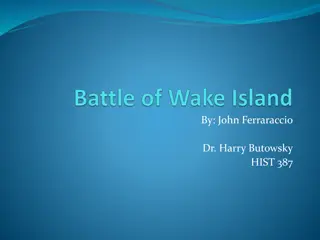Understanding Military Transcripts for Education Credits
Veterans can request their official military transcript online for free, which contains valuable information such as course completions, occupations, test scores, and more. Transferring military credits towards a veteran's educational program can lead to significant cost savings and benefits. Learn about the Joint Services Transcript and why it's essential to review and utilize military transcripts effectively.
Download Presentation

Please find below an Image/Link to download the presentation.
The content on the website is provided AS IS for your information and personal use only. It may not be sold, licensed, or shared on other websites without obtaining consent from the author. Download presentation by click this link. If you encounter any issues during the download, it is possible that the publisher has removed the file from their server.
E N D
Presentation Transcript
Transfer credits from the military
How does a student request a military transcript? Veterans can request their military transcript over the web at https://jst.doded.mil/smart/dodMandatoryBanner.do. There is no charge to the veteran for an official military transcript.
Why should I look at a military transcript? If a student is receiving VA benefits, the military requires us to give credit where appropriate towards a veteran s educational program. The government has saved $150 million in military benefits because military credits have been applied towards college programs. We should not transfer in credits if they do not apply to the veteran s program of study max time frame and veterans benefits limitations. Keep our transfer policy in mind 5 year time limit on technical courses.
Military transcript by branch Effective February 2013, a new military transcript called the Joint Services Transcript because available. The JST is one official standardized military transcript for the Army, Marines, Navy, and Coast Guard. The Air Force will continue to use the Community College of the Air Force for their transcripts.
What does a military transcript look like? Sample transcripts can be viewed online http://www.acenet.edu/news- room/Pages/Transcripts-for-Military-Personnel.aspx
What information is found on a military transcript? Personal service member data Military course completions all courses that have been evaluated by ACE, with full descriptions and credit recommendations Military occupations full descriptions, skill levels, and credit recommendations College-level test scores CLEP, DSSTs, NCPACE, ACT/PEP, and Excelsior Test score data and Other Learning Experiences additional completed courses and occupations not evaluated by ACE for college credit.
What is an MOS? MOS stands for Military Occupational Specialty. It is a job description for a service member. All occupations have ACE ID numbers beginning with 3 letter codes that identify the service. MOS means an Army occupation NER is a Navy rating NEC is a Navy Enlisted Classification NWO is a Navy Warrant Officer LDO is a Navy Limited Duty Officer MCE is a Marine Corps enlisted occupation MCO is a Marine Corps Warrant Officer CGR is a Coast Guard rating and CGW is a Coast Guard Warrant Officer.
What is a military course? This is an actual course offered by a branch of the military. AR is Army NV is Navy MC is Marine Corps AF is Air Force CG is Coast Guard and DD is Department of Defense.
How do I evaluate a military credit? American College on Education (ACE) has evaluated military courses and occupations and their recommendation can be found on the joint services transcript. If two courses or MOS give credit for the same topic, do not add them together. For example, one course may give 3 credits for computer applications and another give 2. You would give the student 3 credits.
But how do I know what was covered in a course? Guide to the Evaluation of Education Experiences in the Armed Services can be found online: http://www.acenet.edu/news-room/Pages/Military- Guide-Online.aspx The Military Guide includes all evaluated courses and occupations from 1954 to the present.
Course Exhibit Back to Results Print Page AR-0419-0057 BASIC FREIGHT TRAFFIC Course Number: Version 1: 8C-F12/553-F1. Version 2: 8C-F12/553-F1. Location: Transportation School, Fort Eustis, VA. Length: Version 1: 2 weeks (28 71 hours). Version 2: 2 weeks (71 hours). Exhibit Dates: Version 1: 10/92 6/08. Version 2: 11/08 Present. Learning Outcomes: Version 1: Before 10/92 see AR-0419-0044. Upon completion of the course, the student will be able to move freight within the US and procure and evaluate commercial transportation services. Version 2: Upon completion of the course, the student will be able to know the roles of commercial carriers in freight movement; understand transportation management concepts, including quality control and security; understand the process of evaluating carrier performance; know the criteria for selecting carriers for freight, including freight charges; and plan and execute the movement of hazardous materials. Instruction: Version 1: Lectures and practical exercises cover commercial transportation systems and procurement of services from commercial sources. Version 2: Practical exercises, discussion, classroom exercises, and lecture. General course topics include freight transportation and logistics. Related Competencies: Version 2: Freight transportation topics include customer service, freight transportation industry overview, hazardous material transportation, introduction to freight transportation, management, operations analysis, planning, and security. Logistics topics include customer service, freight transportation industry overview, hazardous material transportation, introduction to freight transportation, management, operations analysis, planning, and security. Credit Recommendation: Version 1: In the lower-division baccalaureate/associate degree category, 3 semester hours in transportation practices (10/00)(10/00). Version 2: In the lower-division baccalaureate/associate degree category, 3 semester hours in freight transportation or logistics (10/09)(10/09).
How were the courses evaluated? Courses are evaluated by teams of at least three subject matter specialists (college and university professors, deans, and other academicians). Team members reach a consensus on the amount and category of credit to be recommended. Evaluation materials include the course syllabus, training materials, tests, textbooks, technical manuals, and examinations. Additional information may be obtained from discussions with instructors and program administrators, classroom observations, and examination of instructional equipment and laboratory facilities.
Occupational Evaluations Evaluators identify the skills, competencies, and knowledge required of service members in a given occupation specialty and relate that demonstrated learning to the same attributes acquired by students who have completed a comparable postsecondary course or curriculum. Because the evaluations are based on a comparison of learning outcomes, the amount of time a given enlisted service member may have spent acquiring occupational proficiency is not taken into consideration. The emphasis is on translating the learning demonstrated through occupational proficiency into terms used in formal civilian postsecondary education systems to recognize the same learning.
Have some credits already been evaluated by Minnesota West? Yes, as part of a MnSCU initiative, the diesel department and the administrative secretarial department have evaluated the Human Resource Specialist MOS and Light Vehicle Wheeled Mechanic MOS. Minnesota initiative developed VETS Veterans Education Transfer System http://www.mnscu.edu/collegesearch/index.php/vets/searc h. Veterans can see how their courses/MOS will apply to programs.
What if a military course has only covered part of my course content? With permission of the provost/dean of technical education, it is possible to give partial credit and develop a special topics course to cover the missing portion. For example, a student has covered most of the material in RNEW 1115 but is missing an important topic. You could give 2 credits for RNEW 1115 and require a 1 credit special topics course.
Free guide for students at http://www.acenet.edu/news-room/Pages/Military- Transfer-Guide.aspx
More helpful information for veterans My Military Education developed by Minnesota
www.gibill.va.gov developed by the US Dept of Veterans Affairs


